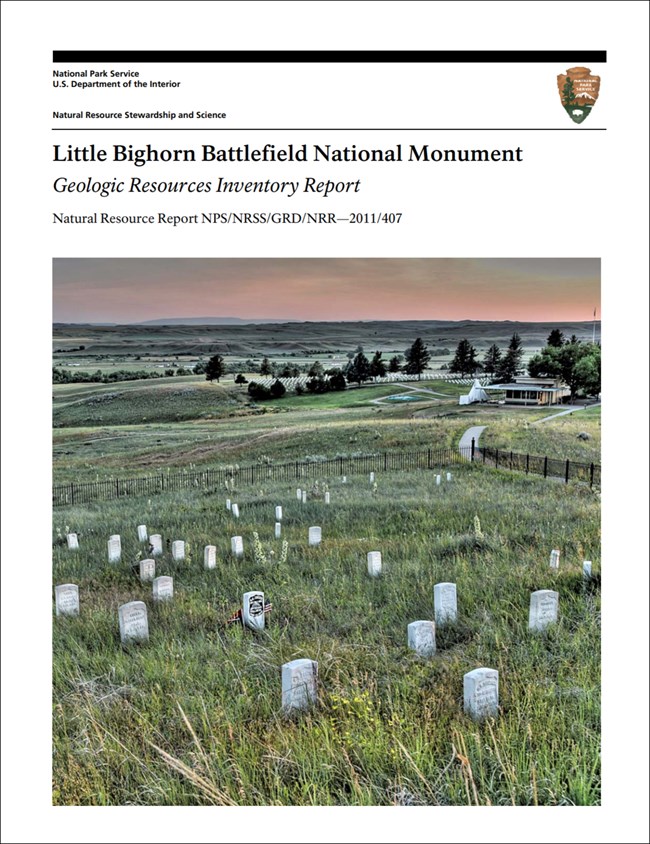Last updated: July 10, 2024
Article
NPS Geodiversity Atlas—Little Bighorn Battlefield National Monument, Montana
Geodiversity refers to the full variety of natural geologic (rocks, minerals, sediments, fossils, landforms, and physical processes) and soil resources and processes that occur in the park. A product of the Geologic Resources Inventory, the NPS Geodiversity Atlas delivers information in support of education, Geoconservation, and integrated management of living (biotic) and non-living (abiotic) components of the ecosystem.

Introduction
Little Bighorn Battlefield National Monument (LIBI), located in southeastern Montana, was originally established as a national cemetery on Jan. 29, 1879, less than three years after the Battle of the Little Bighorn. The national monument memorializes one of the last major victories of the Northern Plains Native Americans to preserve their ancestral way of life, and protects the site where Lieutenant Colonel George A. Custer and all the men under his immediate command met their demise on what is now “Last Stand Hill” (KellerLynn 2011). LIBI was renamed as a national monument Dec. 10, 1991 and encompasses 765 acres of federal land (Anderson 2017). The primary purpose of LIBI is to preserve and protect the historic and natural resources related to the Battle of Little Bighorn, as well as educate visitors about the events surrounding the battle and its resulting effects (KellerLynn 2011).
Geologic Features and Processes
Various geologic landforms dot the landscape of LIBI, with the primary form consisting of ridges dissected by ravines and small stream beds (“coulees”). During the Battle of the Little Bighorn, these ridges provided views across the broad valley and offered defensible high ground for soldiers of the 7th Cavalry (KellerLynn 2011). Ravines and coulees, which cut into the ridges to form trenches, allowed for the shielded advance of the Native American tribes. The bedrock that underlies LIBI is primarily shale and sandstone from the Late Cretaceous Period, about 100 million to 66 million years ago. These geologic units represent sediments originally deposited in the Cretaceous Interior Seaway, a shallow sea that inundated west-central North America. Surficial units consist of Pleistocene (2.6 million to 11,700 years ago) terrace deposits, and Holocene (the past 11,700 years) river alluvium consisting of unconsolidated gravel, sand, silt, and clay. These rocks and unconsolidated deposits give rise to the landforms that ultimately influenced the events and outcomes of the Battle of the Little Bighorn (KellerLynn 2011).
The Geologic Resources Inventory produces digital geologic maps and reports for more than 270 natural resource parks. The products listed below are currently available for this park, check back often for updates as many maps, reports, and posters are still in progress.
-
Scoping summaries are records of scoping meetings where NPS staff and local geologists determined the park’s geologic mapping plan and what content should be included in the report.
-
Digital geologic maps include files for viewing in GIS software, a guide to using the data, and a document with ancillary map information. Newer products also include data viewable in Google Earth and online map services.
-
Reports use the maps to discuss the park’s setting and significance, notable geologic features and processes, geologic resource management issues, and geologic history.
-
Posters are a static view of the GIS data in PDF format. Newer posters include aerial imagery or shaded relief and other park information. They are also included with the reports.
-
Projects list basic information about the program and all products available for a park.
Source: Data Store Saved Search 3806 (results presented are a subset). To search for additional information, visit the Data Store.
Related Articles
Little Bighorn Battlefield National Monument
National Park Service Geodiversity Atlas
The servicewide Geodiversity Atlas provides information on geoheritage and geodiversity resources and values within the National Park System. This information supports science-based geoconservation and interpretation in the NPS, as well as STEM education in schools, museums, and field camps. The NPS Geologic Resources Division and many parks work with National and International geoconservation communities to ensure that NPS abiotic resources are managed using the highest standards and best practices available.

